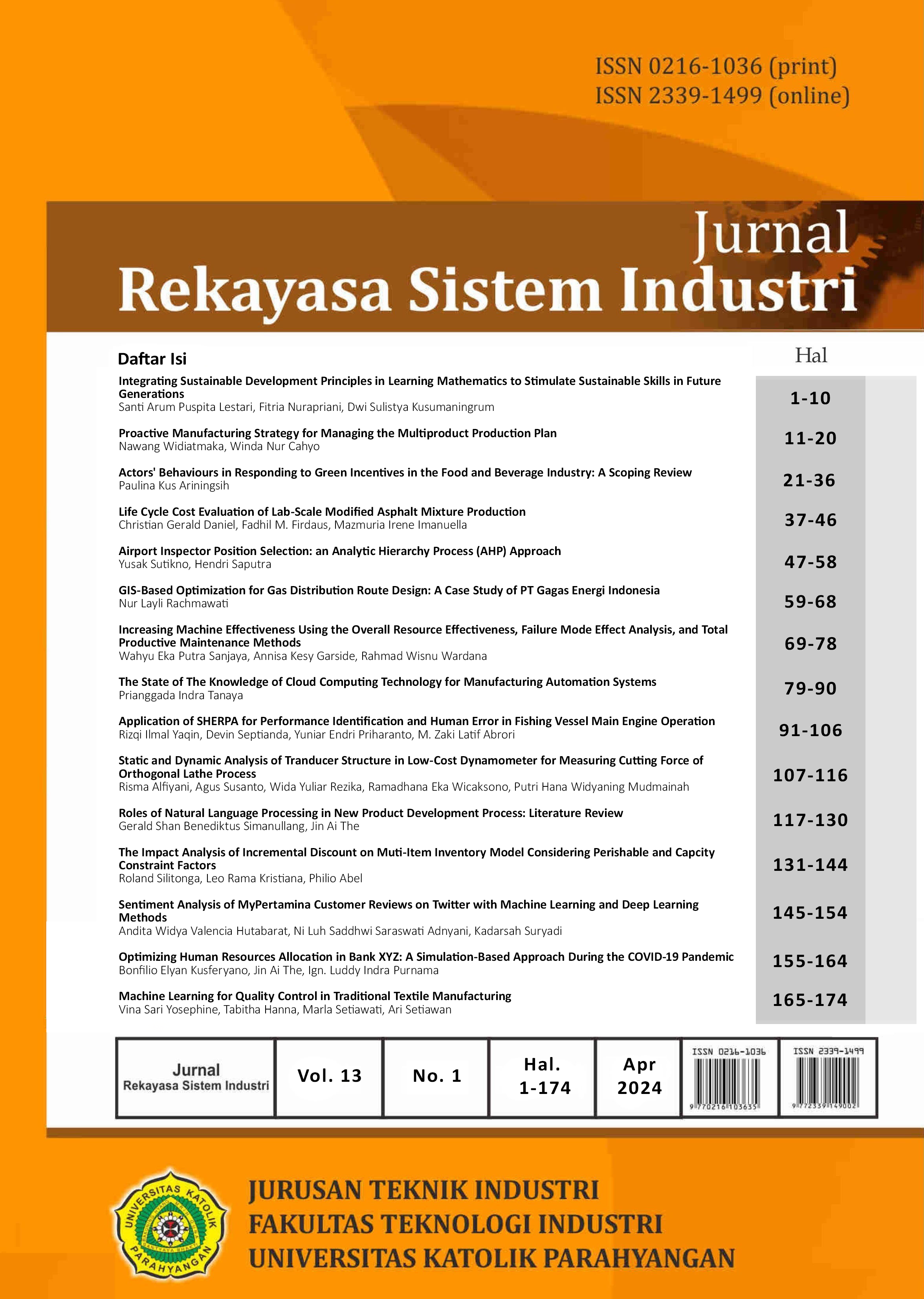The Impact Analysis of Incremental Discount on Multi-Item Inventory Model Considering Perishable and Capacity Constraint Factors
DOI:
https://doi.org/10.26593/jrsi.v13i1.6840.131-144Keywords:
Probabilistic Inventory, incremental discount, perishable, warehouse capacityAbstract
The retail industry engaged in the pharmaceutical sector such as pharmacies sells various types of medicinal products and medical chemicals with fluctuating demand characteristics. This is due to the emergence of diseases that cannot be predicted with certainty. Inventory management is an important aspect to ensure the availability of medicines when needed while still being able to minimize losses both from retained capital on goods and potential expiration. Medicinal products themselves have a certain shelf-life, so products that have expired cannot be used again and cause losses to company. The form of inventory management policy is the order lot size, time between orders and reorder points. To determine the size of the order lot, in addition to the expiration aspect, the limitations of the warehouse as a place of storage and purchase discount factors need to be considered. The existence of a discount policy from suppliers can be used to minimize purchasing costs which are a component of inventory costs. The form of the discount policy that is generally given is the all-unit discount, but for certain types of products the policy given is an incremental discount. The purpose of this study is to build a multi-item probabilistic inventory model by considering the expiration factor, warehouse capacity constraints, and purchasing discount policies. This research will compare two discount policies, namely incremental discount and all unit discount. Based on the results of the sensitivity analysis, it is known that the model is sensitive to the parameters of unit discount provisions, good goods fraction, and holding costs.
References
Ardiansyah, H., Gunawan, G., & Resipitawulan. (2016). Optimisasi Fungsi Nonlinier Dua Variabel Bebas dengan Satu Kendala Pertidaksamaan Menggunakan Syarat Kuhn-Tucker. Prosiding Matematika.
Bahagia, S. N. (2006). Sistem Inventori. Penerbit ITB.
Debora, M., Limansyah, T., & Lesmono, D. (2012). Model Persediaan Deterministik dengan Mempertimbangkan Waktu Kadaluarsa dan Faktor Incremental Discount. Seminar Nasional MATEMATIKA, 07, 70–77.
Lesmono, J. D., & Limansyah, T. (2012). Pengembangan Model Persediaan Probabilistik dengan Faktor Kedaluwarsa dan Incremental Discount. SiMantap , 03, 209–217.
Limanjaya, B., & Silitonga, R. Y. H. (2018). Development of Multi Item Probabilistic Inventory Model by Considering Perishable and Purchase Bonus Factors. Jurnal Telematika Edisi IESC, 54–59.
Limansyah, T., & Lesmono, D. (2011). Model Persediaan Multi Item dengan Mempertimbangkan Faktor Kedaluwarsa dan Faktor All Unit Discount. Jurnal Teknik Industri, 13(2), 87–94.
Prasetyo, H., Munawir, H., & Musthofiyah, N. A. (2005). Pengembangan Model Persediaan Dengan Mempertimbangkan Waktu Kadaluarsa dan Faktor Incremental Discount. Jurnal Ilmiah Teknik Industri, 4, 49–56.
Silitonga, R. Y. H., Budiyono, I. J., & Bautista, C. C. (2022). Development of a Multi-Item Inventory Model by Considering Perishable and Return of Goods in a Hospital Pharmacy. Journal of Novel Engineering Science and Technology, 1(01), 9–14. https://doi.org/10.56741/jnest.v1i01.55
Silitonga, R. Y. H., & Kawet, M. P. (2017). Pengembangan Model untuk Aplikasi Pengendalian Persediaan Probabilistik Multi Item Single Supplier. Jurnal Telematika, 12(1), 13–22.
Silitonga, R. Y. H., & Kezia, C. (2017). Model Pengendalian Persediaan Probabilistik Multi Item Single Supplier dengan Bonus Pembelian. 4th Annual Conference in Industrial and System Engineering.
Silitonga, R. Y. H., Kristiana, L. R., & Parley, T. A. (2021). A Multi-Item Probabilistic Inventory Model that Considers Expiration Factor, All Unit Discount Policy and Warehouse Capacity Constraints. Jurnal Teknik Industri, 23(2), 139–148. https://doi.org/10.9744/jti.23.2.139-148
Tersine, R. J. (1994). Principles of Inventory and Materials Management 4th Edition (4th ed.). Prentice Hall.
Utama, D. M. (2017). Model Penentuan Lot Pemesanan Dengan Mempertimbangkan Unit Diskon dan Batasan Kapasitas Gudang dengan Program Dinamis. Jurnal Teknik Industri, 18(1), 94–102.

